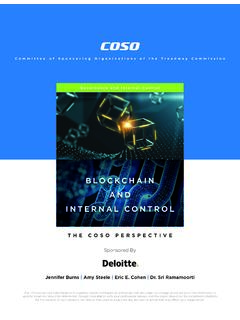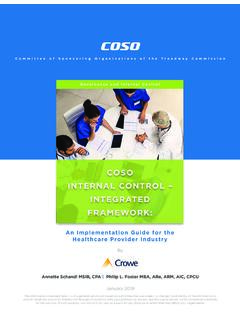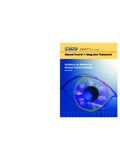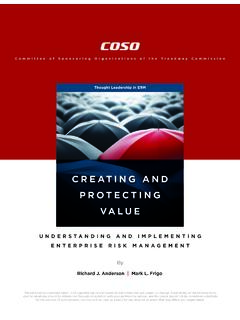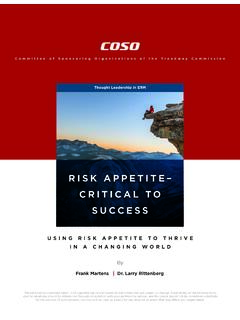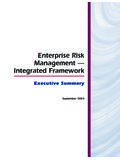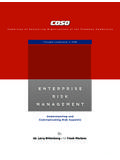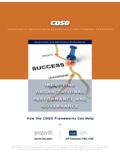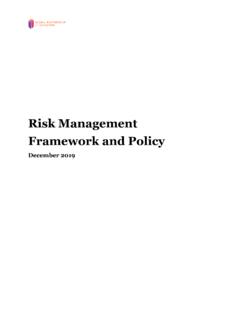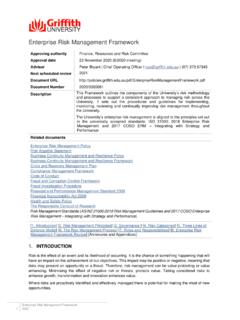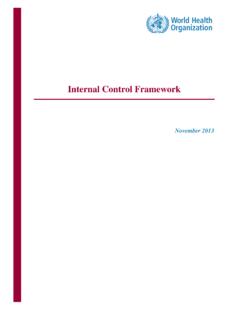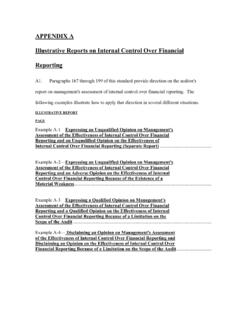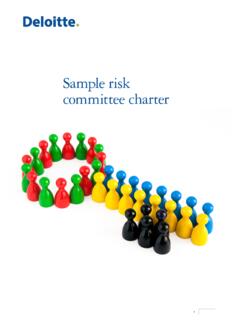Transcription of COMPLIANCE RISK MANAGEMENT: APPLYING THE COSO …
1 Committee of Sponsoring Organizations of the Treadway CommissionByThe information contained herein is of a general nature and based on authorities that are subject to change. Applicability of the information to specific situations should be determined through consultation with your professional adviser, and this paper should not be considered substitute for the services of such advisors, nor should it be used as a basis for any decision or action that may affect your Risk ManagementCOMPLIANCE RISK MANAGEMENT: APPLYING THE coso ERM FRAMEWORKThis project was commissioned by the Committee of Sponsoring Organizations of the Treadway Commission ( coso ), which is dedicated to providing thought leadership through the development of comprehensive frameworks and guidance on enterprise risk management, internal control, and fraud deterrence designed to improve organizational performance and governance and to reduce the extent of fraud in is a private-sector initiative jointly sponsored and funded by the following organizations.
2 American Accounting Association (AAA) American Institute of CPAs (AICPA) Financial Executives International (FEI) The Institute of Management Accountants (IMA) The Institute of Internal Auditors (IIA)Committee of Sponsoring Organizationsof the Treadway Board MembersPaul J. SobelCOSO ChairDouglas F. PrawittAmerican Accounting AssociationRobert D. Dohrer American Institute of CPAs (AICPA)Daniel C. MurdockFinancial Executives InternationalJeffrey C. ThomsonInstitute of Management AccountantsPatty K. MillerThe Institute of Internal AuditorsSociety of Corporate COMPLIANCE and Ethics & Health Care COMPLIANCE Association (SCCE & HCCA) Enterprise Risk Management | COMPLIANCE Risk Management: APPLYING the coso ERM framework | iCommittee of Sponsoring Organizations of the Treadway CommissionNovember 2020 Research Commissioned byResearch Commissioned byEnterprise Risk ManagementCOMPLIANCE RISK MANAGEMENT: APPLYING THE coso ERM | Enterprise Risk Management | COMPLIANCE Risk Management: APPLYING the coso ERM FrameworkCopyright 2020, Committee of Sponsoring Organizations of the Treadway Commission ( coso ).
3 1234567890 PIP 198765432 coso images are from coso Enterprise Risk Management - Integrating with Strategy and Performance 2017, The American Institute of Certified Public Accountants on behalf of the Committee of Sponsoring Organizations of the Treadway Commission ( coso ). coso is a trademark of the Committee of Sponsoring Organizations of the Treadway Rights Reserved. No part of this publication may be reproduced, redistributed, transmitted, or displayed in any form or by any means without written permission. For information regarding licensing and reprint permissions, please contact the American Institute of Certified Public Accountants, which handles licensing and permissions for coso copyrighted materials.
4 Direct all inquiries to or AICPA, Attn: Manager, Licensing & Rights, 220 Leigh Farm Road, Durham, NC 27707 USA. Telephone inquiries may be directed to 888-777-7077. Design and production: Sergio Enterprise Risk Management | COMPLIANCE Risk Management: APPLYING the coso ERM framework | iii1. Introduction 12. Governance and Culture for COMPLIANCE Risks 7 3. Strategy and Objective-Setting for COMPLIANCE Risks 11 4. Performance for COMPLIANCE Risks 15 5. Review and Revision for COMPLIANCE Risks 22 6. Information, Communication, and Reporting for COMPLIANCE Risks 27 Appendix 1. Elements of an effective COMPLIANCE and ethics program 31 Appendix 2. International growth in recognition of COMPLIANCE and ethics programs 37 Acknowledgments 39 About SCCE & HCCA 39 About coso 40 Contents | Enterprise Risk Management | COMPLIANCE Risk Management: APPLYING the coso ERM Enterprise Risk Management | COMPLIANCE Risk Management: APPLYING the coso ERM framework | 1 Why this publication is neededCompliance risks are common and frequently material risks to achieving an organization s objectives.
5 For many years, COMPLIANCE professionals have used a widely accepted framework for COMPLIANCE and ethics (C&E) programs to prevent and timely detect noncompliance and other acts of wrongdoing. The C&E program framework is described in Appendix 1 (if readers are not already familiar with the elements of a C&E program, consider reading Appendix 1 before proceeding). The coso Enterprise Risk Management (ERM) framework , meanwhile, has been used by risk and other professionals to identify and mitigate a variety of organizational risks, including COMPLIANCE publication aims to provide guidance on the application of the coso ERM framework to the identification, assessment, and management of COMPLIANCE risks by aligning it with the C&E program framework , creating a powerful tool that integrates the concepts underlying each of these valuable are COMPLIANCE and COMPLIANCE -related risks?
6 Risk is defined by coso as the possibility that events will occur and affect the achievement of strategy and business objectives. Risks considered in this definition include those relating to all business objectives, including COMPLIANCE . COMPLIANCE risks are those risks relating to possible violations of applicable laws, regulations, contractual terms, standards, or internal policies where such violation could result in direct or indirect financial liability, civil or criminal penalties, regulatory sanctions, or other negative effects for the organization or its personnel. Throughout this publication, events associated with COMPLIANCE risks will be referred to as noncompliance or COMPLIANCE violations.
7 Although the underlying acts (or failures to act) are carried out by individuals, COMPLIANCE violations are generally attributable to the organization when they are carried out by employees or agents of the organization in the ordinary course of their duties. The exact scope of acts attributable to an organization can vary depending upon the circumstances. In some cases, the employee may also bear liability as an COMPLIANCE violations either inherently cause harm or have the potential to result in direct harm to individuals, communities, or organizations. Examples of parties that may be harmed through COMPLIANCE violations include customers ( , violations of privacy or data security laws leading to a breach and theft of personal information, product safety violations resulting in injuries, antitrust violations resulting in inflated prices), employees ( , workplace safety regulation violations resulting in injury to a worker, antidiscrimination or whistleblower protection law violations), or the general public ( , environmental violations resulting in illness or death).
8 Although most COMPLIANCE risks relate to specific laws or regulations, others do not. These other risks, referred to as COMPLIANCE -related risks, may include risks associated with failures to comply with professional standards, internal policies of an organization (including codes of conduct and business ethics), and contractual obligations. For example, conflicts of interest represent violations of laws or regulations only in limited instances (frequently involving government officials or programs). Conflicts of interest are frequently prohibited by professional standards, terms of contracts and grant agreements, or internal policies, and they are viewed as damaging to an organization if they are not disclosed and managed.
9 As a result, conflicts of interest are commonly included within the population of COMPLIANCE risks. Accordingly, throughout this publication, the term COMPLIANCE risk is used in reference to any risk that is either directly associated with a law or regulation or is COMPLIANCE -related in that it is associated with other standards, organizational policies, or ethical expectations and this discussion illustrates, the scope of what an organization considers to be COMPLIANCE risks is not an exact science, although most organizations use a similar list of COMPLIANCE risk areas within the universe of their programs ( , environmental, bribery, and corruption), even if the specific COMPLIANCE risks within each area may differ.
10 Determining the exact scope of a C&E program is typically 1. | Enterprise Risk Management | COMPLIANCE Risk Management: APPLYING the coso ERM Frameworkboth an early step in developing the program and an ongoing exercise as the risk landscape changes, and input from COMPLIANCE , legal, senior leaders, and the board are violations often result in fines, penalties, civil settlements, or similar financial liabilities. However, not all COMPLIANCE violations have direct financial ramifications. In some cases, the initial impact may be purely reputational. However, reputational damage often leads to future financial or nonfinancial harm, ranging from loss of customers to loss of employees, competitive disadvantages, or other effects ( , suspension, debarment).
